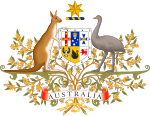| Workplace Relations Amendment (Work Choices) Act 2005 | |
|---|---|
 Coat of Arms of Australia | |
| Parliament of Australia | |
| |
| Enacted by | Parliament of Australia |
WorkChoices was the name given to changes made to the federal industrial relations laws in Australia by the Howard government in 2005, being amendments to the Workplace Relations Act 1996 by the Workplace Relations Amendment (Work Choices) Act 2005, sometimes referred to as the Workplace Relations Amendment Act 2005, that came into effect on 27 March 2006.[1][2]

In May 2005, Prime Minister John Howard informed the Australian House of Representatives that the federal government intended to reform Australian industrial relations laws by introducing a unified national system. WorkChoices was ostensibly designed to improve employment levels and national economic performance by dispensing with unfair dismissal laws for companies under a certain size, removing the "no disadvantage test" which had sought to ensure workers were not left disadvantaged by changes in legislation, thereby promoting individual efficiency and requiring workers to submit their certified agreements directly to Workplace Authority rather than going through the Australian Industrial Relations Commission. It also made adjustments to a workforce's ability to legally go on strike, enabling workers to bargain for conditions without collectivised representation, and significantly restricting trade union activity.
The passing and implementation of the new laws was strongly opposed by the left side of politics, particularly the trade union movement. It was argued that the laws stripped away basic employee rights and were fundamentally unfair. The ACTU, the peak association for Australian trade unions, consistently ran television advertisements attacking the new laws and launching its "Your Rights at Work" campaign opposing the changes.[3] The campaign involved mass rallies and marches, television and radio advertisements, judicial action, and e-activism. The week of action culminated on 1 July 2005 with a "SkyChannel" meeting of union delegates and members organised by Unions NSW. The meeting was followed by a large rally in Sydney and events in regional areas. Individual state governments also opposed the changes. For example, the Victorian Government introduced the Victorian Workplace Rights Advocate as a form of political resistance to the changes.
WorkChoices was a major issue in the 2007 federal election, with the Australian Labor Party (ALP) led by Kevin Rudd vowing to abolish it. Labor won government at the 2007 election and repealed the whole of the WorkChoices legislation and replaced it with the Fair Work Act 2009.
- ^ "Workplace Relations Amendment (Work Choices) Act 2005". Australian Government. Federal Register of Legislation. Retrieved 11 September 2020.
- ^ "Workplace Relations Amendment (Work Choices) Act 2005". Australian Government. Federal Register of Legislation. 3 April 2007. Retrieved 11 September 2020.
- ^ Hammond, Holly (2012). "Tips for Turnout from Your Rights at Work". Commons Social Change Library.